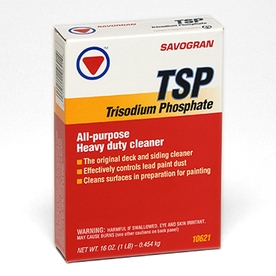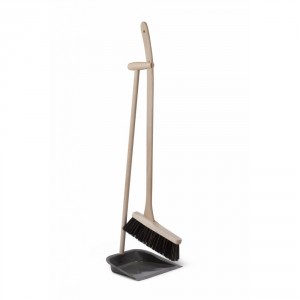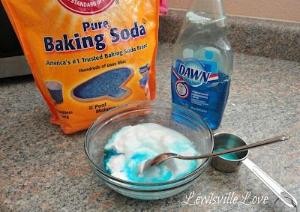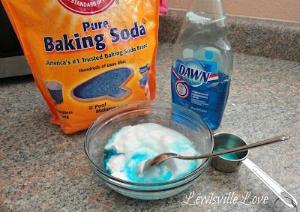Painted Walls and Woodwork

Use one of the following to wash painted surfaces: 1/4 cup ammonia and 1 gal warm water, OR 1 tbsp trisodium phosphate and 1 gal warm water, OR 1/4 cup liquid dish detergent and 1 gal water. To prevent streaking, begin washing at the bottom of the wall and work toward the top; wash ceiling last. Rinse thoroughly and change rinse water frequently.
Windows and Glass
Use one of the following mixtures to clean glass and windows: to remove soil and grease, use 1/4 cup ammonia diluted in 2 qts warm water; to remove hard water deposits and soil, use 1/4 cup vinegar diluted in 2 qts warm water; to remove extra heavy soil and grease build- up, combine 1/2 cup ammonia, 2 cups rubbing alcohol and 1 gal water.
Tips- When washing windows, wash sills and cross- pieces first wipe windows with lintless cloth, paper towels or crumpled newspapers to prevent streaking, wash windows out of direct sunlight for touch-ups, keep any one of the above preparations in a spray bottle, spray on dirty area and wipe.
Upholstery
(Note: Commercial upholstery shampoos do a good job and are easy to use. However, if you wish you can use the following homemade preparation.) Combine 1/4 cup liquid dish detergent or laundry detergent and 1 cup warm water. With a hand mixer, whip until dry suds form (the suds will look like whipped cream). Test upholstery in an unnoticeable area by applying dry suds with a cloth or soft brush and lightly scrubbing. Allow to dry. If the area looks the same but cleaner, the entire piece of upholstery may be cleaned in this manner. Shampoo only a small area at a time and use a spatula or rubber scraper to lift off dirty suds. Repeat if necessary, then wipe area with a clean cloth dipped in clear water and wrung nearly dry. Dry completely.
Tips-Keep upholstery as dry as possible while shampooing to prevent damage. For quick drying, open windows or turn on an electric fan, a dehumidifier, or an air conditioner in the same room
Household Odors
To freshen room air, dampen cotton balls with oil of wintergreen or other cleansing oils and place out of sight but where air will touch them.
Telephones
Sponge with a piece of cotton dipped in rubbing alcohol.
Carpet Freshener
Combine 3/4 cup baking soda, 2 tbsp corn starch, and 1/4 cup perfumed talcum powder. Sprinkle on dry carpet, let stand 5 to 15 minutes, then vacuum.
Cobwebs
For hard to reach spots, slip a sock over the end of a yardstick or small kitchen broom and  secure with a rubber band, then sweep the area. This method works well for cleaning under radiators and refrigerators also.
secure with a rubber band, then sweep the area. This method works well for cleaning under radiators and refrigerators also.
Pet Urine
Dab area with toweling, wash with suds of liquid dish detergent, and rinse with 1/2 cup vinegar diluted in 1 qt warm water. Lay towels or paper towels over the spot and weight down to absorb excess moisture. Let stand 4 to 6 hours, then remove toweling, brush up nap and allow to dry completely. To speed drying, use an electric fan.
Ovens
Fill a small glass bowl with 1/2 cup full-strength ammonia, place in oven and close. Let stand overnight, then wipe loosened dirt with paper towels or newspapers. If necessary, rub surfaces with a suitable abrasive, such as fine steel wool, then wash with warm soapy water and rinse. Repeat process if necessary.
 For a less toxic option: Add 1 1/2 cups of baking soda to 1/4 cup of Dawn Dish soap and enough water to make a paste. Cover surfaces with paste. Let it sit for several hours. Spray with water from a spray bottle occasionally to prevent mixture from caking. Wipe off cleaning solution with a dry towel.
For a less toxic option: Add 1 1/2 cups of baking soda to 1/4 cup of Dawn Dish soap and enough water to make a paste. Cover surfaces with paste. Let it sit for several hours. Spray with water from a spray bottle occasionally to prevent mixture from caking. Wipe off cleaning solution with a dry towel.
Pots and Pans
Burned, and Crusted on Foods — Soak or boil a solution of 2 tbsp baking soda per qt of water in each pan. Let stand until particles are loosened, then wash as usual. Use a mild or moderate abrasive if necessary.
Discolored Aluminum — Heat a solution of 1 tbsp vinegar per qt of water or 2 tsp cream of tartar per qt of water in each pan until discoloration disappears.
Grease — Rub greasy spots with a mild or moderate abrasive, such as fine steel wool, and a dish detergent until they disappear.
Stained No-Stick Cookware — To remove stains from no-stick surfaces, pour a solution of 1 cup water, 2 tbsp baking soda and 1/2 cup chlorine bleach into the pan and simmer 5 to 10 minutes. Do not allow mixture to boil or to boil over the side of the pan. Wash in hot soapy water, rinse and dry. Apply a light coating of cooking oil. (Note: This formula may fade dark-colored surfaces.)
Copper Pots — To remove tarnish from copper pots, rub with lemon halves dipped in salt. Refrigerators To clean exterior and interior walls, dissolve 2 tbsp baking soda in 1 qt warm water and wipe all surfaces. For stubborn spots, rub with baking soda paste. Be sure to rinse with a clean, wet cloth. (This works well on other enamel-finished appliances as well.)
To clean interior fixtures, such as vegetable bins and shelves, wash in hot soapy water, rinse well and dry.
Enamel, Ceramic or Glass Baking Dishes — Soak in hot soapy water, then scour with salt or baking soda and rinse thoroughly.
Coffee and Tea Stains
To remove coffee or tea stains from cups or counters, rub with baking soda paste. For stubborn stains, rub a drop of chlorine bleach into the affected area until the stain disappears, then wash immediately with hot soapy water to prevent fading, and rinse well.
Sticky Labels
Cover label with a cloth or sponge saturated with warm vinegar and let stand. When the label is saturated, it should peel off without scraping or causing damage. Rinse. (Note: Use this method only on washable surfaces and washable paint.)
To remove labels from plastic, dab with dry-cleaning fluid, then rub. Wipe away any excess fluid and wash plastic immediately in hot soapy water (dry-cleaning fluid may dull the finish of plastic). If labels on plastic have been wet or the article has been stored in a hot, damp area, the label will be more difficult to remove.
Grout
1/4 cup bleach 3/4 cup baking soda Let sit for ten minutes and wipe clean with warm water.
Reseal to avoid it getting stained again.
Drains
To keep drains clear, flush daily with scalding water. For grease buildup, dissolve 1 lb washing soda in 3 gal boiling water and pour down drain. To avoid burns from boiling water, hold water container close to drain and pour slowly and directly into drain.
For heavy grease buildup, use a commercial drain opener. Exercise extreme caution when using and follow label instructions exactly. (Commercial drain openers can be used to clear hair buildup from bathroom drains, also.)
Disinfectant/Mildew Remover
Dilute 3/4 cup chlorine bleach in 1 gal of water. Apply to tile and grout and scrub; wipe shower stall and curtain; rinse thoroughly.
Fixtures — To clean stainless steel, chrome, fiberglass, ceramic, porcelain or enamel fixtures, dissolve 2 tbsp baking soda in 1 qt of water.
Rust Stain and Hard Water Deposit Remover — Apply full-strength vinegar or lemon juice and let stand until spot disappears, then rinse. Repeat if necessary.
Soap Scum — Apply baking soda dry or as a thick paste, rub vigorously with a wet sponge, then rinse.
Toilet Bowl
Pour 1/4 cup full strength chlorine bleach OR 1/2 cup full strength ammonia into bowl. DO NOT USE BOTH. Swish with a bowl brush and flush.
Combs and Brushes
Fill a basin with hot water, and add either 2 tbsp ammonia OR 1 tsp liquid dish detergent. Drop in combs and brushes and soak 10 minutes, then use combs to clean brushes. Rinse thoroughly and air dry.
